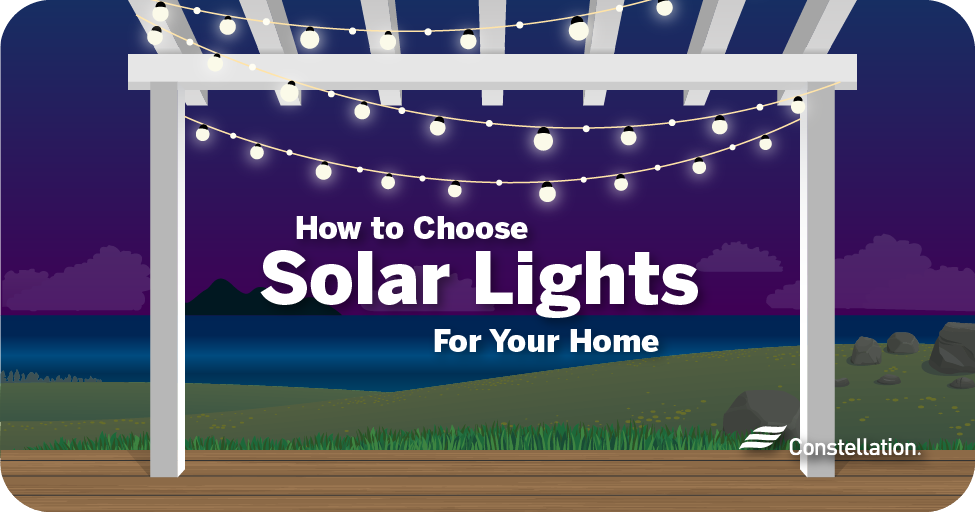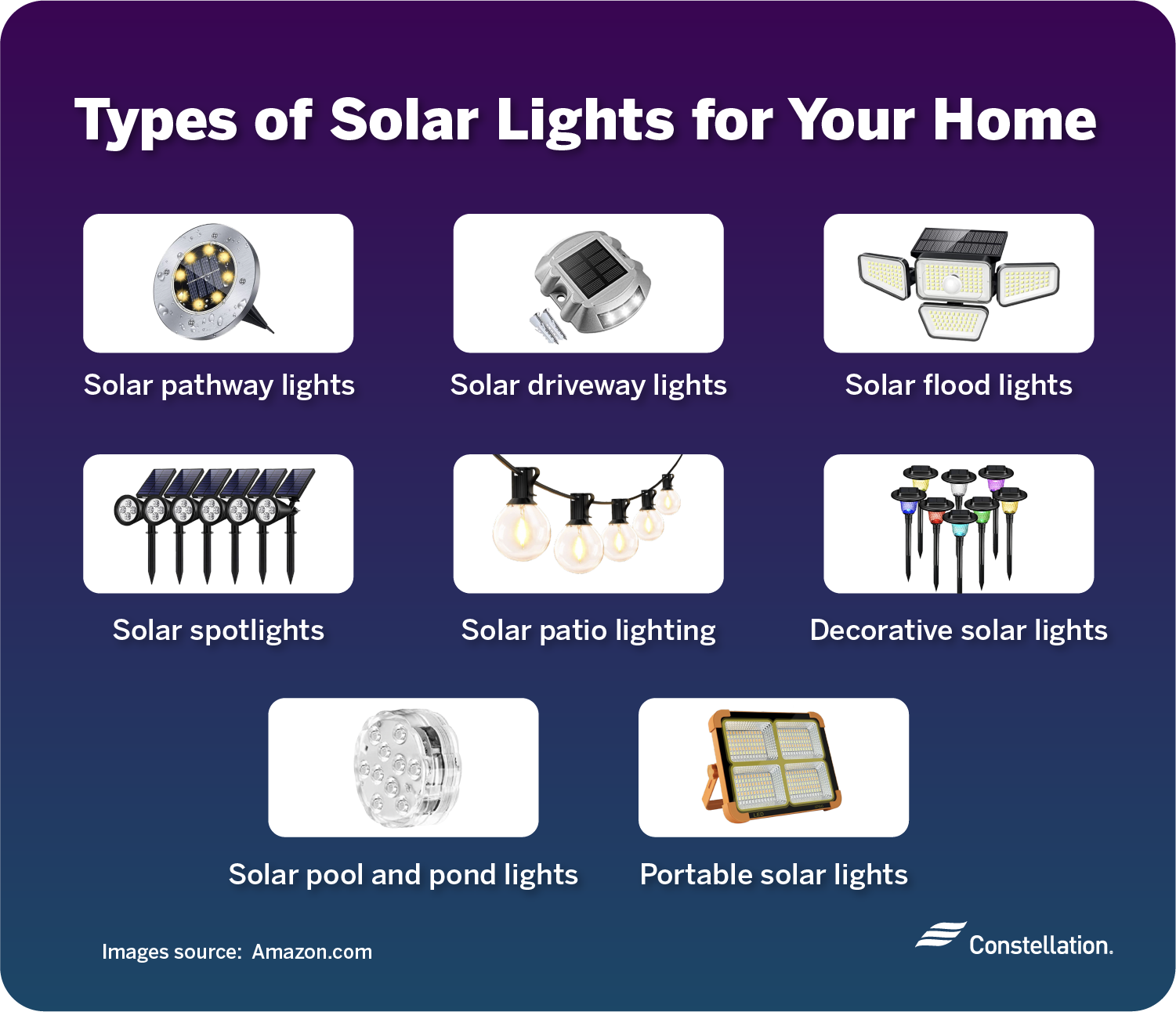
- Category:
Home Energy Savings -
Last updated:
April 4, 2022
How to Choose Solar Lights for Your Home
With so many options, knowing how to choose solar lights can be a challenge. Here is some advice that will help you make the best selections for your home.
How do solar lights work?
Before going into the details about types of outdoor solar lights, it helps to understand how solar lights work.
Solar lights have a photovoltaic cell, battery, light bulb and photosensor. The light bulbs are usually CFL or LED. The photovoltaic cell is the device that turns the sun’s light into electricity that is then stored in the battery to power the light bulb.
The photosensor automatically controls when your solar lights go on and off by sensing visible light. When it senses no light, it completes the circuit between the battery and light bulb and the light goes on. When it senses sunlight, it breaks the circuit and the light goes off.
Different types of solar lights for your home

How to choose solar lights depends on your lighting needs. You have a multitude of types of outdoor solar lights for energy-efficient outdoor lighting.
- Solar pathway lights. Lighting pathways makes it safer to walk outside after dark. They can also be attractive accents in the design of your landscape.
- Solar driveway lights. Make it easier to navigate home from the street with lights that keep you on the drive and off the plantings.
- Solar flood lights. If you have a large area to light, solar flood lights are a great option. You can also use them to highlight plantings around your home.
- Solar spotlights. These are some of the brightest solar lights on the market and are ideal for work areas and security. The brightness drives away pests and is a good way to protect your home from wildlife.
- Solar patio lighting. You can set a mood and light up an area for entertaining or relaxing in your yard.
- Decorative solar lights. Christmas lights bring a festive look to your home over the holidays and decorative fairy lights can turn an ordinary yard into something magical. In both cases, you can find energy-efficient decorative lights that fit your sense of style.
- Solar pool and pond lights. Designed to work immersed in water, these lights add delightful ambiance to your yard waterscapes.
- Portable solar lights. Portable solar lanterns and candles can decorate a table or light your walk in the dark.
7 factors to consider when choosing outdoor solar lights
The popularity of solar lights has led to a dizzying array of choice in the market. Here are the factors to consider in how to choose an outdoor solar light.
1. Purpose
Know how you plan to use your solar lights before shopping. Will you need it for a specific function like security and safety, or are you looking for decorative fixtures? Each use will lead to different design choices and functions.
2. Desired brightness
Brightness is now measured in lumens. Lumens is a more useful measure than the old wattage measurement. An old-fashioned 40 watt incandescent light bulb puts out between 300 to 500 lumens. An LED light with the same number of lumens burns only three to five watts.
3. Solar panel type
The three most common solar panels used to power solar lights are amorphous, polycrystalline and monocrystalline.
Amorphous have one photovoltaic layer over the whole surface of the unit. They are thin, flexible, and lightweight.
Monocrystalline solar panels are composed of a single silicon solar cell. They are rigid and heavy, but they are a top performer when it comes to efficiently producing electricity.
Polycrystalline solar panels are made of several silicon crystal pieces fused together. Like the monocrystalline variety, they are heavy and rigid. They are budget-friendly.
4. Battery type
You need your solar lights to work at night with no sun. That is where batteries come in. Batteries store electrical energy as chemical energy in reactions that occur when energy is stored and released.
Lead acid batteries work when the sulphuric acid reacts to the lead. Other battery types include NiCad or nickel-cadmium batteries and NiMH nickel batteries with cadmium replaced by metal hydride. Each has performance differences in charge time, energy storage, weight and length of lifespan.
5. Recharge time and run time
Be sure to know how long each model takes to recharge and how long they will run between charges. You may need a battery that lasts all night–or longer. Running batteries down to zero repeatedly shortens their life dramatically.
6. Type of bulb
Most energy-efficient outdoor lighting uses LED technology. They are dramatically more energy-efficient than incandescent bulbs and don’t run the risk of releasing toxins into the environment if broken like CFL bulbs. They are also longer lasting. Here are some comparisons of types of solar lights bulbs:
- 40 watt incandescent = 10 watt CFL or 3 watt LED
- 60 watt incandescent = 14 watt CFL or 6 watt LED
- 100 watt incandescent = 28 watt CFL or 13 watt LED
You can buy a blazingly bright 3,000 lumen LED security flood light or pool lights that range from 1,000 to 20,000 lumens. On the other end of the spectrum are tiny 1.2 lumen colorful fairy lights you can string in your trees.
7. Features and accessories
The features and accessories you need are an important part of how to choose solar lights. You have manual and automated options and some are smart devices for your garden. Other types change color and intensity.
The benefits of using solar lights
People buy solar lights for a number of different reasons:
- Reduce your environmental impact. Solar lights are energy efficient and don’t draw power from the grid.
- Simple installation and maintenance. With no wires, you can easily put them anywhere for trouble-free operation.
- Limit your energy expenses. The cost of solar lighting continues to fall, with additional cost savings on your electric bill. Using them is one great summer energy-saving tip.
- Automation. Solar lights fit well with other outdoor automation ideas.
Frequently asked questions about solar lights
You might have a few questions before you go shopping for solar lights. Here are some answers.
Where’s the best place to install outdoor solar lights?
Lighting your doorway, walks and driveway enhances safety. You can hang lights or put them into the ground. They can also be useful as part of your automated home security system.
Do solar lights need direct sunlight?
Your lights will not adequately charge in the shade. Solar cells generally need direct sunlight. Check the specs for nightly run time and recommended charging conditions.
Do solar lights charge on cloudy days?
Solar lights will still charge on cloudy days, but at a much slower rate.
Do solar lights work in the winter?
Depending on where you live, the sun may be lower on the horizon all day, lowering the efficiency of your solar panels. You can tilt them to face in a more southerly direction for a little boost in charging.
Do solar lights need batteries to work?
Your solar lights get energy only when the sun is charging the solar panel, which is why you need a battery. The light charges the battery all day so that the electricity can be used through the dark of the night.
How long do solar lights usually last?
Solar cells and LED bulbs can last a few decades. The battery will be the first thing to wear out. They usually need replacing every two to three years. Be sure to check that batteries are replaceable to avoid the waste of throwing out the whole unit when they reach the end of their lifespan.
Solar lights are an excellent choice if you are looking for low cost installation and energy efficiency without sacrificing style. You can have a safely and beautifully lighted home with minimal maintenance and expense.




